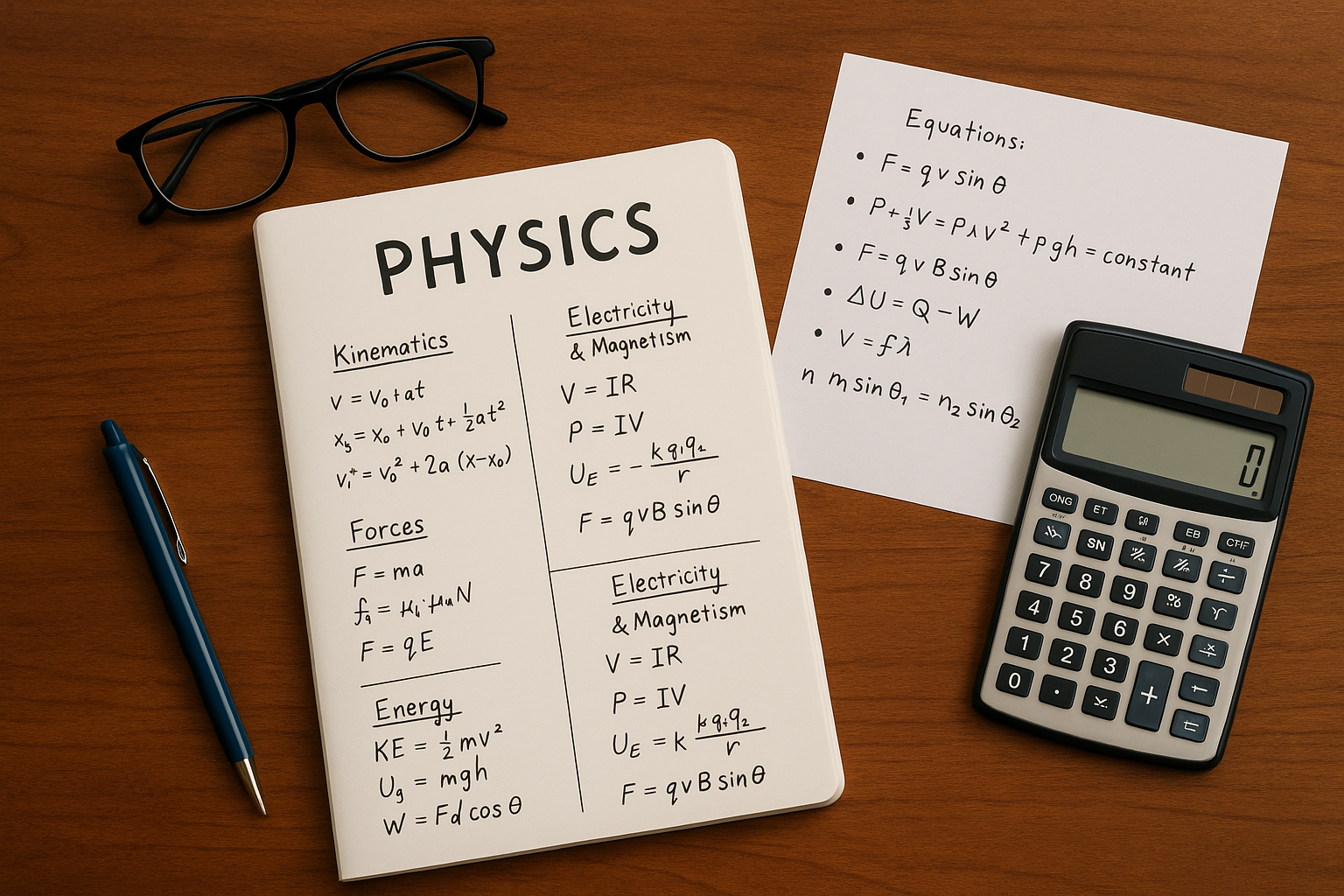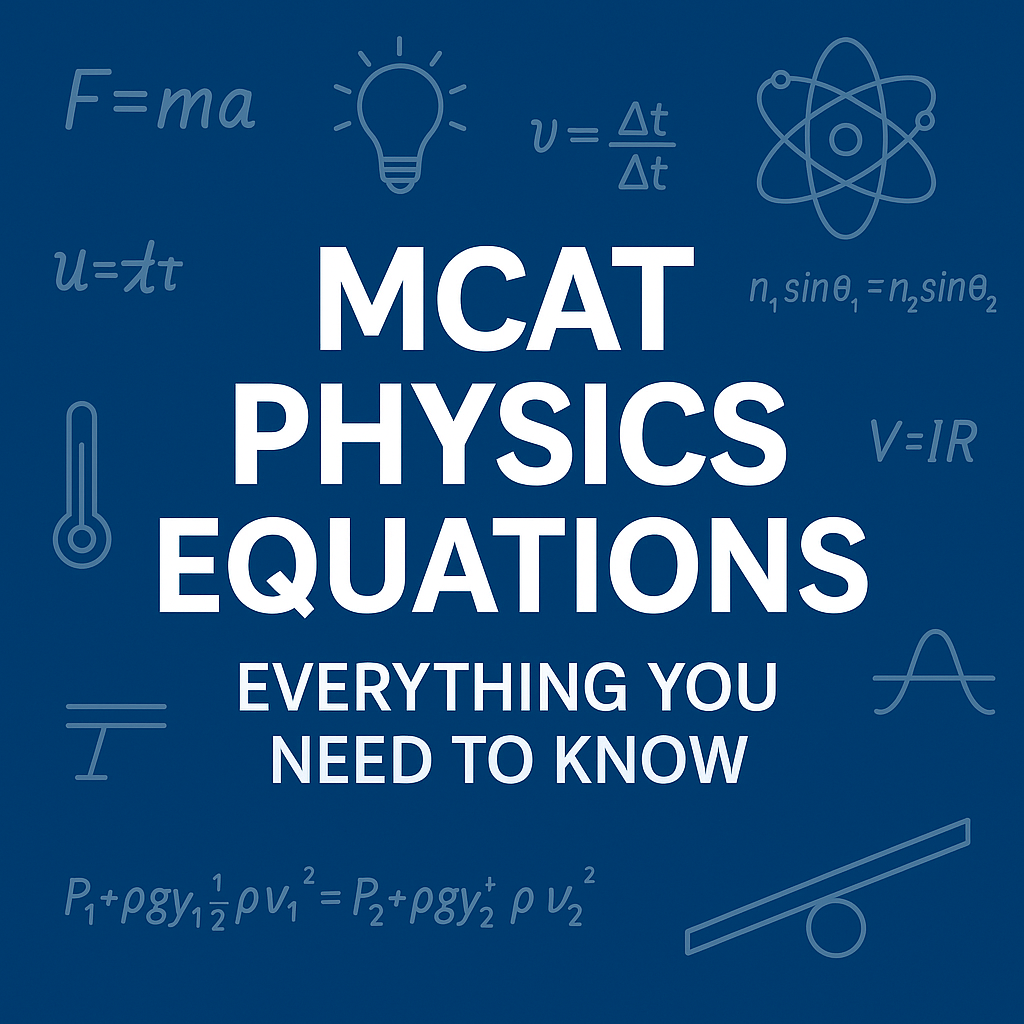
Physics is one of the most challenging subjects for many MCAT test takers. With its mathematical nature and wide range of concepts, it often feels like a barrier to a competitive score. However, mastering MCAT physics does not mean memorizing every detail from your college courses. It requires a targeted understanding of the core equations and knowing how to apply them efficiently under exam conditions.
The MCAT focuses heavily on applying physics principles to biological and chemical systems. This means you will encounter questions that test your ability to reason with formulas, recognize relationships between variables, and manipulate equations to solve problems quickly. Success depends on more than just memorization—it requires understanding the underlying concepts and practicing how to use them effectively.
In this guide, we provide a comprehensive breakdown of the most important MCAT physics equations. This resource is designed to help you:
- Learn and memorize high-yield physics formulas for the MCAT
- Understand the meaning and application of each equation in a test setting
- Practice using equations with step-by-step solutions to sample problems
- Develop strategies to recall and apply formulas efficiently during the exam
By the end of this article, you will have a solid framework for approaching MCAT physics confidently. Whether you are starting your preparation or looking to refine your physics knowledge in the final weeks before test day, this guide is your complete reference to mastering MCAT physics equations.
Understanding MCAT Physics: Why Focus on Equations?
The physics portion of the MCAT often feels overwhelming because it spans multiple disciplines: mechanics, electricity and magnetism, fluids, thermodynamics, waves, and optics. But here’s the key insight—most physics questions on the MCAT do not require deep theoretical knowledge. Instead, they test your ability to apply a set of core equations to real-world biological and chemical systems.
According to the AAMC’s MCAT content outline, about 25% of the Chemical and Physical Foundations of Biological Systems (C/P) section relies on physics concepts. These questions are integrated into passages and stand-alone items, often requiring you to identify the right formula and manipulate it correctly.
Why Are Equations So Important?
Physics on the MCAT is applied, not memorized. For example, a question may describe the flow of blood through a vessel and ask you to calculate the pressure difference. Without knowing Bernoulli’s equation or the relationship between pressure, flow rate, and resistance, you’ll spend precious time trying to reason through the problem, or worse, guess.
Equations help you:
- Quickly recognize what is being asked in a complex passage.
- Save time by providing a direct path to the solution.
- Avoid common errors like unit mismatches or misinterpreting variables.
- Link physics concepts to biology and chemistry, as the MCAT expects interdisciplinary thinking.
How Many Equations Do You Need to Memorize?
The MCAT does not provide an equation sheet during the exam. That means you are expected to recall and apply formulas on your own. The good news is that the list of must-know equations is finite. Most MCAT prep experts agree that mastering 40–50 high-yield formulas is enough to cover nearly every physics concept tested.
Examples include:
- Kinematics equations for motion
- Newton’s laws for forces
- Work-energy relationships
- Fluid dynamics (Bernoulli and Poiseuille equations)
- Basic electricity and magnetism formulas
You can find these equations in resources like Khan Academy’s MCAT physics course and AAMC’s official guide.
Active Recall and Practice Are Essential
Simply reading equations is not enough. The MCAT rewards students who practice retrieving these formulas and using them under time constraints. Tools like flashcards, equation sheets, and targeted practice problems can help reinforce memory. Platforms such as Anki and UWorld provide spaced repetition systems that are ideal for mastering this content.
By building a strong foundation in physics equations, you turn a traditionally intimidating subject into one of your strengths. The next section provides a detailed list of all the high-yield physics formulas you need for the MCAT, along with explanations and examples of how to apply them.
List of Must-Know MCAT Physics Equations
The MCAT tests physics concepts in ways that often integrate biology and chemistry. Memorizing equations is not enough—you need to understand what they represent and when to apply them. Below is a comprehensive list of high-yield MCAT physics equations organized by topic.
Mechanics
Kinematics Equations (Linear Motion)
These equations describe the motion of objects under constant acceleration:
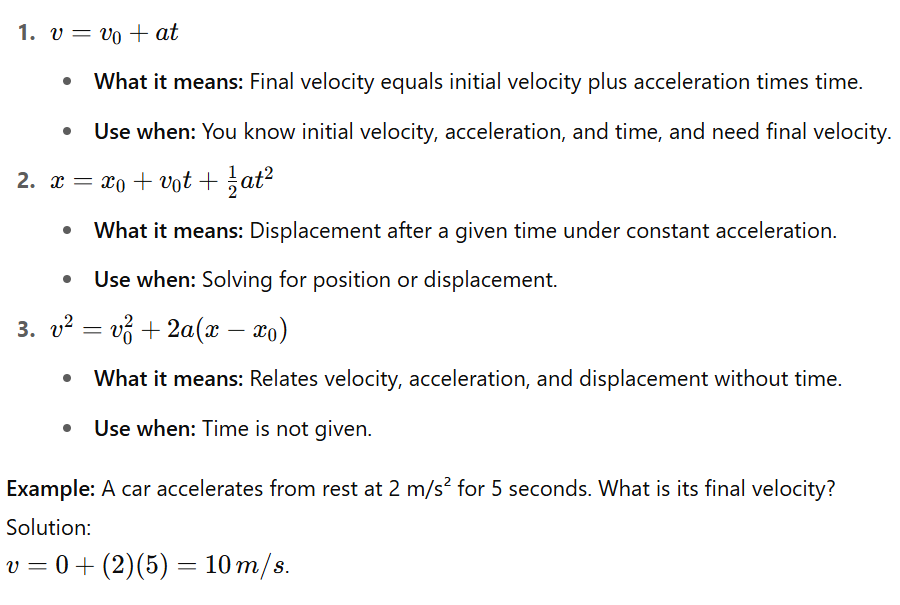
Newton’s Laws of Motion
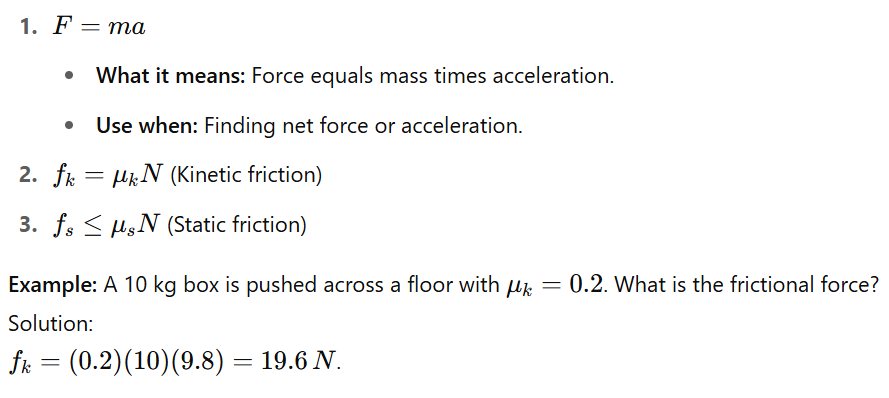
Work, Energy, and Power
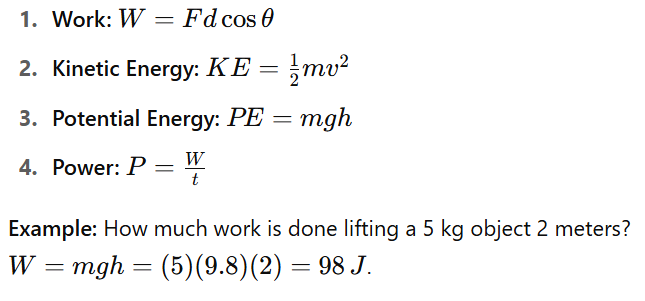
Momentum and Collisions

Fluid Mechanics
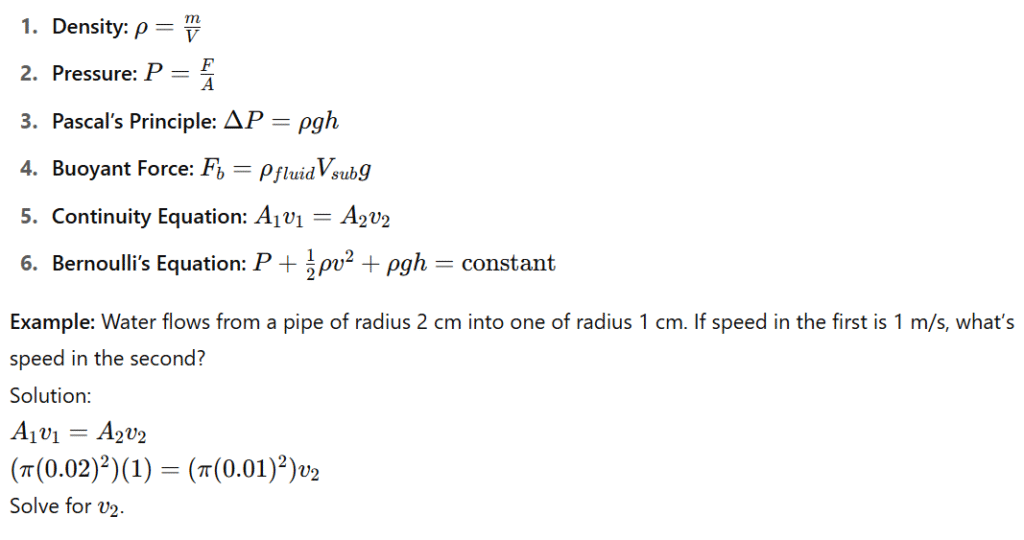
Thermodynamics
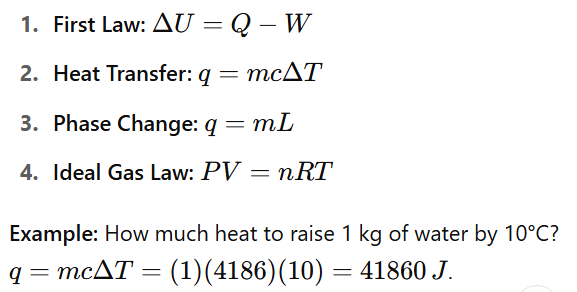
Electricity and Magnetism
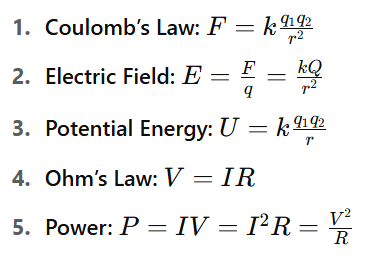
Waves and Optics
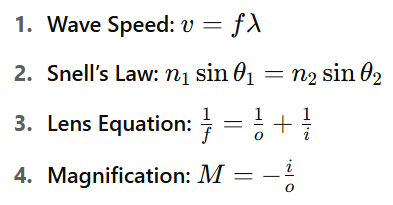
Tips to Memorize and Apply MCAT Physics Equations
Memorizing equations for the MCAT is only half the battle. The real challenge lies in knowing how to apply them correctly under timed conditions. The exam rarely asks for straightforward calculations. Instead, it tests your ability to identify which formula fits a particular scenario and how to manipulate it efficiently.
Here are proven strategies to help you both memorize and apply physics equations effectively.
1. Use Active Recall Instead of Passive Review
Passive reading or highlighting your notes will not help you retain formulas. Active recall forces your brain to retrieve information, strengthening memory.
- Create flashcards for each formula. One side has the concept or scenario (e.g., “Work done by a force at an angle”), and the other has the equation:

- Digital flashcard tools like Anki or Quizlet are excellent because they use spaced repetition, automatically reviewing harder cards more often.
2. Focus on Conceptual Understanding
The MCAT often tests concepts behind formulas rather than direct calculations. Knowing what each variable means and why the formula works allows you to adapt quickly to unfamiliar situations.
For example:
- Understanding Bernoulli’s equation as a statement of energy conservation in fluids helps you recognize it in questions about blood flow.
- Knowing that:

describes the magnetic force on a moving charge, making it easier to identify when charges will curve in a magnetic field.
Khan Academy’s MCAT Physics Course is a free resource that teaches these concepts alongside the equations.
3. Practice with MCAT-Style Questions
Applying formulas under time constraints is crucial. Use resources like AAMC’s Official MCAT Question Packs or UWorld to practice. Focus on:
- Recognizing clues in passages that hint at which formula is needed.
- Manipulating equations algebraically to isolate the desired variable before plugging in numbers.
- Unit analysis to check if your answer makes sense.
4. Create a Personal Formula Sheet
While you cannot bring a formula sheet to the exam, creating one during your prep helps reinforce memory. Include:
- All high-yield MCAT physics equations.
- Notes on common pitfalls or assumptions (e.g., “Neglect air resistance unless stated”).
- Diagrams or mnemonic devices to aid recall.
Review this sheet daily in the final weeks before test day.
5. Understand Units and Constants
The MCAT tests your grasp of SI units and dimensional analysis. Memorize units for common quantities (e.g., Joules for energy, Pascals for pressure) and know constants like:

This allows you to check equations for consistency and avoid errors.
6. Practice Deriving Equations When Possible
You don’t need to derive equations on test day, but practicing derivations during prep can strengthen your understanding. For instance:
- Derive kinematic equations from definitions of acceleration and velocity.
- Derive Bernoulli’s equation from energy conservation.
This makes the formulas easier to remember and apply flexibly.
By integrating these techniques into your study plan, you will build not only memory but also confidence in using physics equations efficiently.
Common Mistakes Students Make with MCAT Physics Equations
Physics questions on the MCAT are designed to test more than formula memorization. They challenge you to recognize when and how to use equations under pressure. Even high scorers often lose points because of predictable, avoidable mistakes. Here is a detailed breakdown of the most common errors students make with MCAT physics equations—and how you can avoid them.
1. Memorizing Equations Without Conceptual Understanding
Many students treat MCAT physics as a memorization task, creating long lists of formulas to cram. While this might work temporarily, it falls apart on the MCAT because questions rarely ask for direct application of a formula. Instead, they often test your understanding of relationships between variables.
Example of the mistake:

How to fix it:
- Spend time understanding what each variable means and how changes affect the outcome (e.g., inversely, directly).
- Practice rewriting formulas in different forms to see variable relationships.
- Use conceptual questions from resources like Khan Academy’s MCAT physics course to test understanding.
2. Ignoring Units and Dimensional Consistency
Units are your built-in error checker, but they’re often overlooked. The MCAT can exploit this by providing answer choices that differ only by factors of ten or unit mismatches.
Example of the mistake:

How to fix it:
- Always include units in every calculation step.
- Double-check unit conversions, especially for energy (Joules vs. eV) and pressure (Pascals vs. mmHg).
- Learn dimensional analysis: check if your answer’s units match what’s being asked.
3. Over-Reliance on Plug-and-Chug
Many students try to solve physics problems by picking a formula and plugging in numbers without thinking about whether the formula applies. This approach works for straightforward problems but often fails on the MCAT’s more conceptual questions.
Example of the mistake:

How to fix it:
- Start by asking: What concept is this question testing?
- Identify known and unknown variables before selecting a formula.
- Practice rearranging equations algebraically rather than relying on calculators early.
4. Forgetting Simplifications and Underlying Assumptions
Physics equations often assume idealized situations—frictionless surfaces, incompressible fluids, or point charges. Forgetting these assumptions can lead to applying the wrong formula.
Example of the mistake:
Applying Bernoulli’s equation to blood flow in a vein without considering viscosity or resistance.
How to fix it:
- Review the conditions under which each formula applies.
- Read MCAT questions carefully for clues about approximations. For fluids, ask: Is this laminar flow (Poiseuille) or turbulent flow (Reynolds number)?
5. Poor Time Management When Applying Equations
Even if you know all the right formulas, the MCAT’s strict timing can cause panic if you don’t retrieve them quickly. Students often waste time flipping through mental lists of formulas instead of immediately narrowing down the possibilities.
Example of the mistake:
Spending 3–4 minutes trying to recall the ideal gas law derivation rather than moving on and returning later.
How to fix it:
- Drill high-yield equations daily with flashcards for rapid recall.
- Practice under timed conditions with full-length exams from AAMC.
- Create “trigger words” for each formula (e.g., “flow rate” = Poiseuille’s law).
6. Failing to Link Equations Across Topics
The MCAT often integrates multiple physics concepts in one question. Students who learn formulas in isolation struggle when asked to combine them.
Example of the mistake:

How to fix it:
- Practice multi-step problems that combine equations from different topics.
- Study how energy conservation connects mechanics, thermodynamics, and fluid dynamics.
By anticipating these mistakes and correcting them in your preparation, you can approach MCAT physics equations with confidence and accuracy. This proactive approach not only saves time on test day but also reduces avoidable errors that can cost valuable points.
Practice Questions with Step-by-Step Solutions
Question 1: Mechanics – Kinematics
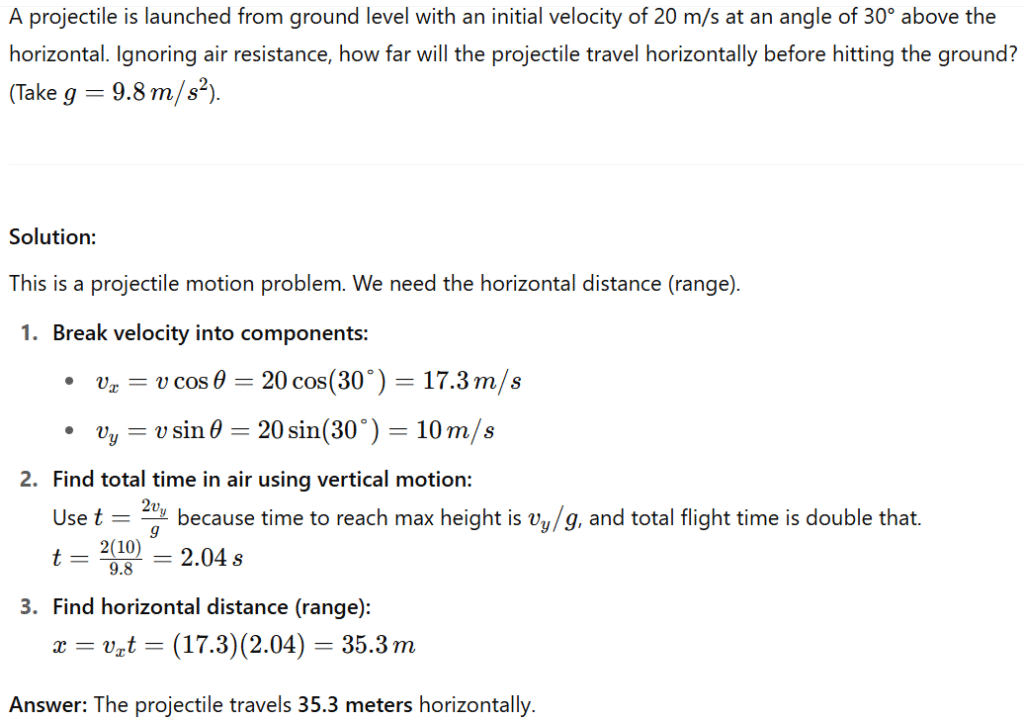
Question 2: Fluids – Bernoulli’s Equation
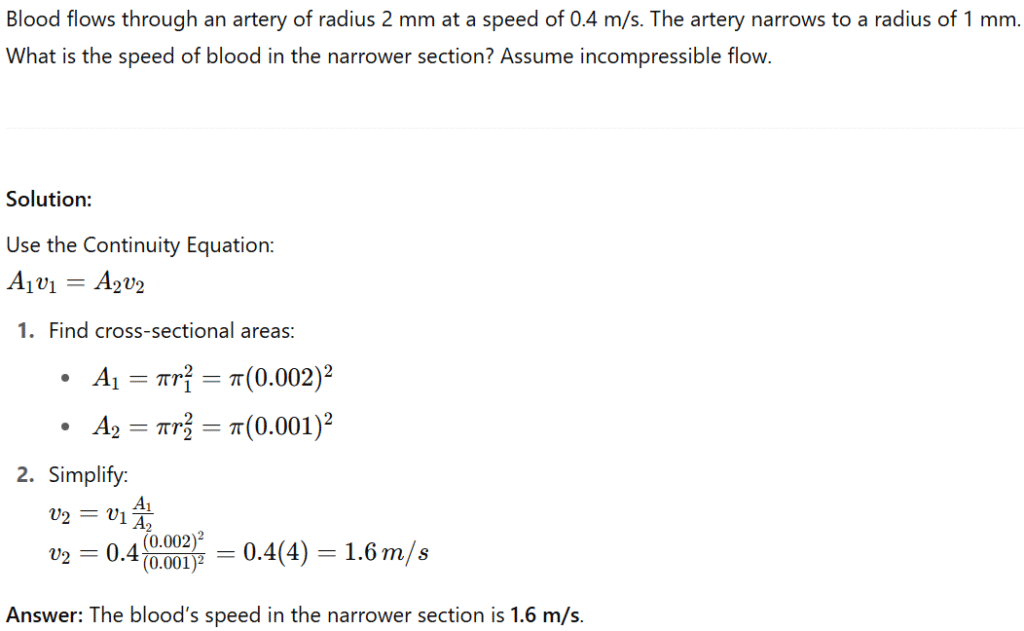
Question 3: Electricity – Ohm’s Law and Power
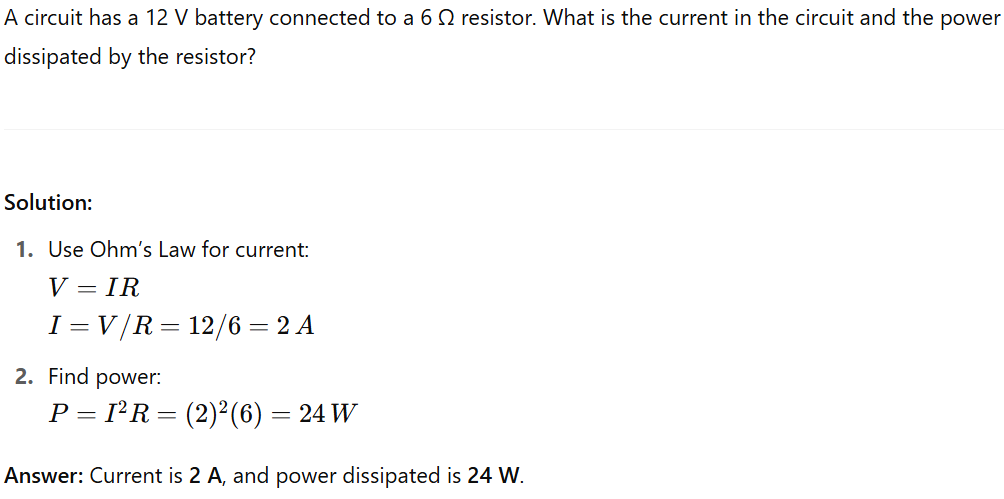
Question 4: Thermodynamics – Heat Transfer
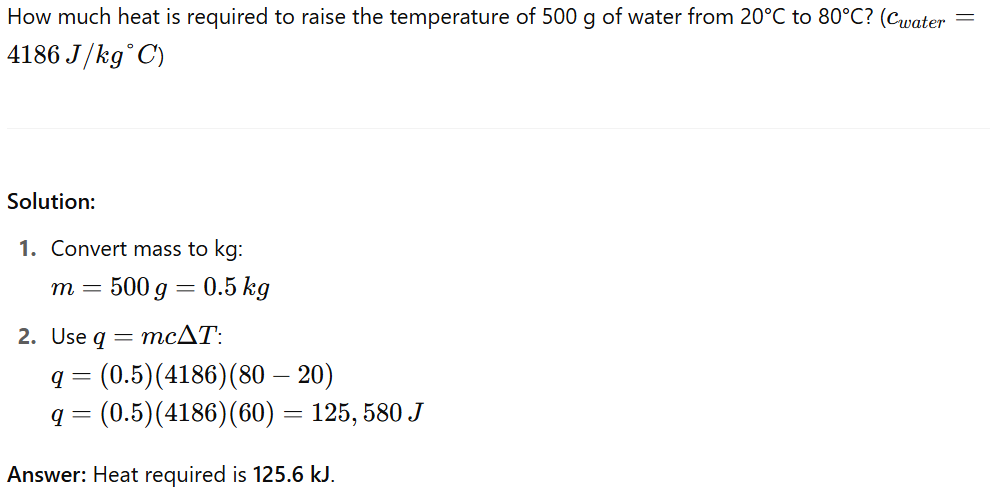
Question 5: Waves – Snell’s Law
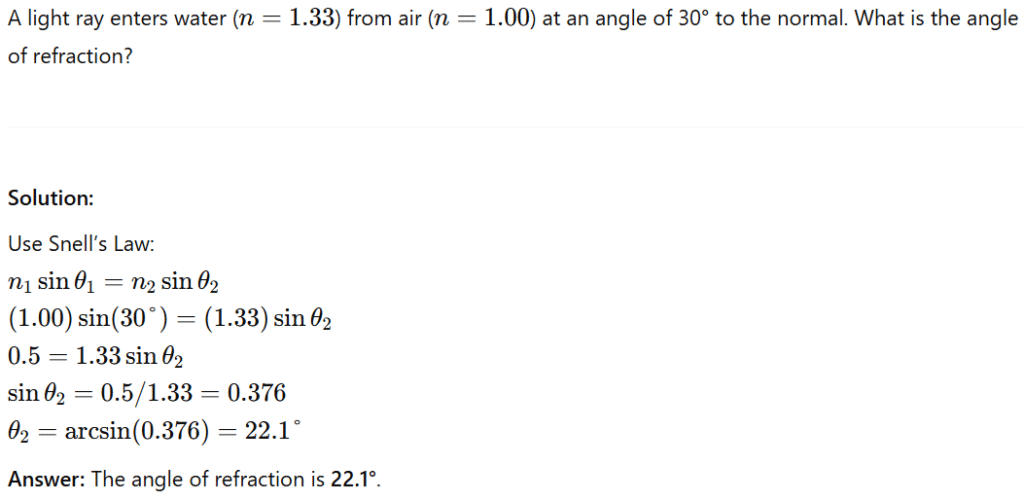
This kind of practice reinforces not just formula recall but also problem-solving strategies under MCAT-style constraints.
Final Thoughts: Mastering MCAT Physics Equations
Mastering MCAT physics equations is less about memorizing an endless list and more about understanding how and when to use them. The exam rewards those who can quickly recognize the underlying physics concepts in a passage and apply the appropriate formula with confidence.
By focusing on high-yield equations, practicing active recall, and solving problems in a timed setting, you can turn physics from a weakness into one of your strongest sections. Use resources like the AAMC question packs, Khan Academy’s MCAT physics course, and practice exams to build familiarity and speed.
Remember, the MCAT doesn’t test your ability to derive complex formulas; it tests your ability to reason scientifically. The equations are tools—not hurdles—and with consistent practice, they can become second nature.
Approach your prep with a strategic mindset, and these equations will not only help you tackle physics questions but also improve your overall test-taking confidence.
Frequently Asked Questions
1. Do I really need to memorize all MCAT physics equations?
Yes, memorizing the essential physics equations is critical because the MCAT does not provide a formula sheet. However, this doesn’t mean memorizing everything from your college physics textbook. Focus on high-yield formulas such as those for kinematics, energy, electricity, and fluids—roughly 40–50 key equations. These cover nearly all situations you’re likely to encounter. Pair memorization with practice to ensure you can recall and apply them quickly under exam conditions.
2. Are MCAT physics questions mostly conceptual or calculation-based?
The MCAT includes both, but the emphasis is slightly more on conceptual understanding. You’ll often be asked how changing one variable impacts another or how to interpret a graph related to physical principles. That said, calculation-based questions still appear and require a solid grasp of equations. These are usually straightforward if you know the formulas and can manipulate them efficiently. Developing both conceptual understanding and calculation speed is essential to perform well in this section.
3. What is the best strategy for memorizing MCAT physics equations quickly?
Start with active recall techniques. Create flashcards for each formula and use spaced repetition apps like Anki to review them daily. Group formulas by topic (e.g., all mechanics equations together) to see how concepts interconnect. Writing out the equations by hand also helps strengthen memory. Finally, practice using the formulas in timed, MCAT-style questions so recall becomes automatic. Memorization is just step one—application is what really matters.
4. Are there resources that provide a complete list of MCAT physics equations?
Yes. Many MCAT prep companies like Kaplan and Princeton Review include condensed formula sheets in their course materials. Free resources such as Khan Academy’s MCAT physics section also cover all high-yield equations with explanations and practice problems. Creating your own formula sheet during prep is highly recommended as it reinforces memory and becomes a quick reference tool in the weeks leading up to the exam.
5. Can I ignore physics and focus on other MCAT sections if it’s my weak area?
Not advised. Physics accounts for about 25% of the Chemical and Physical Foundations of Biological Systems section. Neglecting it could significantly lower your score. Instead of avoiding it, focus on the most frequently tested topics and formulas. With consistent practice and strategic study, even students with weak physics backgrounds can achieve proficiency. Start small and build confidence by mastering one topic at a time.
